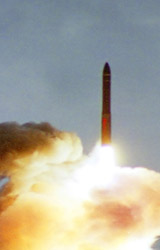| Home | Blog | Ask This | Showcase | Commentary | Comments | About Us | Contributors | Contact Us |

Aren't hair-trigger nuclear missiles a target for terrorists?ASK THIS | May 10, 2004This article is reprinted from the January/February 2004 edition of The Defense Monitor, a publication of the Center for Defense Information in Washington, DC. Permission for its use here has been granted by CDI and the writer. Q. True or false: Since they are no longer enemies, and haven't been for years, the United States and Russia no longer have launch-ready nuclear missiles pointed at each other. Answer: way false, and isn't this worth reporting on every now and then? Q. Would you say having thousands of these missiles ready to launch within minutes is an invitation to terrorists? What do you think the odds are that terrorists will try to get access and fire these missiles? And is this a risk the world really needs to take? Q. Aside from the threat from terrorists, isn't having thousands of missiles ready to launch within minutes a danger in and of itself? Q. And shouldn't we be asking candidates for President and other offices their views: Would they make changes or not? If yes, what would the changes be? If not, why not? By Bruce Blair For all the talk about rogue states acquiring nuclear weapons to threaten the United States, and all the heated debate about the United States developing mini-nukes and bunker busters to keep the rogues at bay, the U.S. nuclear weapons establishment does not pay much attention to the "axis of evil." The real obsession of the U.S. nuclear enterprise at all levels — from Strategic Command in Omaha to the bomb custodians and designers in New Mexico — is keeping U.S. nuclear forces prepared to fight a large-scale nuclear war at a moment’s notice with … Russia. The dirty little secret of America’s current nuclear policy is that 99 percent of the nuclear weapons budget, planning, targeting, and operational activities still revolves around this one anachronistic scenario. The rationale is a throw-back to the Cold War, but however absurd, it still is the axis of current nuclear operations. Scratch Russia from the list of enemies — as it should be — and all justification for maintaining a large U.S. nuclear arsenal evaporates. There would be no planning to build a new factory — possibly in New Mexico — to produce plutonium triggers by the hundreds annually to support a U.S. arsenal of thousands of nuclear bombs. The drumbeat to resume nuclear testing to ensure the reliability of aging bombs would end. The drive to develop new bunker busters, reputedly to target rogue states but really meant to put at risk high-level nuclear command bunkers inside two mountains in Russia, would lose its impetus. The many tens of billions of dollars spent each year on operating and upgrading the thousands of U.S. bombs would be saved. The U.S. has more than 10,000 nuclear bombs. Why? The United States and Russia currently possess 96 percent of the world’s total inventory of 30,000 nuclear weapons. Most of the remainder belongs to U.S. allies and friends — Britain, France and Israel. The combined arsenals of Pakistan and India, with whom the United States enjoys reasonable relations, represent a small fraction of 1 percent. That leaves China, hardly an enemy, whose 1 percent of the world total includes 20 long-range missiles that could hit the United States (compared to 6,000-plus U.S. nuclear weapons that could reach China today). Then there is North Korea, which possibly has a couple of weapons but no missiles or planes capable of dropping them on U.S. targets. The other proliferant states of concern — notably Iran — do not yet possess a single nuclear bomb. A small fraction of the current U.S. arsenal of 10,650 bombs would amply cover all plausible nuclear threats to the American homeland, U.S. allies and interests overseas, if only the idea of fighting a large-scale nuclear war with Russia received the ridicule it deserves. Reasonable people not only scoff at the obsolete idea that the United States must be prepared for such a war in order to deter it, but also appreciate the many unnecessary risks incurred by clinging to this outdated world view. This anachronistic nuclear thinking has perpetuated the risky practice of keeping a hair-trigger on early warning and decision-making, as well as nuclear missile forces. Warning crews in Cheyenne Mountain, Colo., are allowed only three minutes to judge whether initial attack indications from satellite and ground sensors are valid or false. Judgments of this sort are rendered daily, as a result of events as diverse as missiles being tested, or .red — for example, Russia’s firing of Scud missiles into Chechnya — peaceful satellites being lofted into space, or wildfires and solar reflections off oceans and clouds. If an incoming missile strike is anticipated, the president and his top nuclear advisors would quickly convene an emergency telephone conference to hear urgent briefings. For example, the war room commander in Omaha would brief the president on his retaliatory options and their consequences, a briefing that is limited to 30 seconds. All of the large-scale responses comprising that briefing are designed for destroying Russian targets by the thousands, and the president would have only a few minutes to pick one if he wished to ensure its effective implementation. The order would then be sent immediately to the underground and undersea launch crews, whose own mindless .ring drill would last only a few minutes. These tight timelines for decision-making at all levels are driven by only one scenario — a sudden, massive Russian attack. What if terrorists can spook early warning systems? The risks of launching on false warning, or by some unauthorized action, posed by this pressure-packed, decision-making-by-checklist may have been acceptable during the Cold War, but not today. Why carry such high risks if they stem from a totally fictitious threat? Ironically, the U.S. hair-trigger posture forces Russia into an identical stance, and the risks of a false alarm on the Russian side have grown since the end of the Cold War due to the steady deterioration of its early warning and command system. By acting as though Russia may intentionally attack, the United States is exposing itself to a real threat of unintentional Russian attack. By keeping thousands of nuclear weapons fueled, armed, targeted, and ready to fire upon receiving a couple of short computer signals, the United States and Russia are further playing roulette with another real danger: nuclear terrorism. Keeping weapons cocked on hair-triggers raises many terrifying questions in the light of the global terrorist threat. Could terrorists spoof U.S. or Russian early warning systems, causing false alarms and semi-automatic responses that lead to and over the brink of nuclear war? If scores of heavily armed Chechens could take over a theater in Moscow, could terrorists seize mobile intercontinental Russian missiles, figure out how to circumvent the safeguards, and .re them? Could terrorists electronically hack into missile launch circuits from remote locations, or into the communications network used to command strategic missiles, and cause an unauthorized launch? If these scenarios sound far-fetched, remember that foresight of terrorist scenarios is much less than perfect, as the Sept. 11, 2001, hijackings revealed. And consider this: A past Pentagon review found a gaping hole in the computer security of a Navy radio network used to transmit launch orders to U.S. nuclear missile submarines. The investigation found that unauthorized persons, including terrorist hackers, might be able to slip electronically inside the network, seize control over the radio transmitters, and illicitly send fake orders to the boats. The deficiency was deemed so serious that the sub launch crews had to be given elaborate new instructions for validating launch orders, in order to ensure that they would not .re upon receipt of phony orders. All of the thousands of U.S. and Russian launch-ready weapons only represent an accident waiting to happen and a temptation to terrorists to gain control over them. Maintaining these large, cocked arsenals is not needed to prevent a nuclear war between the United States and Russia, nor does it deter terrorists or provide a useful tool in fighting them. Doing so instead represents a grave danger to the civilized world if these weapons fall into the wrong hands. Russia is no longer the enemy. We deny this truth at our own peril and expense. Facing and accepting this truth lights a path to deep nuclear reductions and true security.
|
|
|||||||||||




